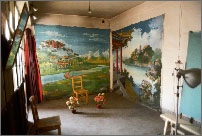Yesterday in Aba we met a family of Tibetan girls ranging in age from 18 to 35. Both parents had died. They were on their own, and making the best of it. The sisters ran a restaurant, a hotel, and an internet cafe. Each was impressive. The youngest were hard workers and had an almost Japanese manner about them. The oldest had an obvious sense of style (her restaurant, extraordinary for Aba, would not be out of place in New York).
The middle daughter spoke English, one of her five languages. She showed us around town and the monastery. At night she took us to a "Tibet dance party". All the while we had conversations about her life, her future, her boyfriend (a Tibetan man who is living illegally in New York) and so on. The talking continued well into the night and although we were all tired I kept getting the sense she didn't want us to go. After the dancing we returned to her sister's restaurant. It was almost 2 at this point and after some more chatting I said we should be going... She looked at me and with piercing frankness said, "You are lucky. Your world is very big. You can travel where you want and do what you want and you are free. You have friends in many places. Maybe I am just a friend you will forget. My world is small. I am not free. I will not forget this talk or this night. Maybe you will return. But maybe you will never come here again." And then she stopped and looked down.
I promised to look up her boyfriend and to send some English books, but there was a truth to what she said, the traveler collects people and experiences and often forgets them or forgets to look at them as people whose lives they might have touched. But not always....
Today I returned to the small village of Amchok. I had stayed with the headmaster and his wife many years ago (pictures here and here). I returned with a batch of pictures from my first visit in 1994. The town was still recognizable, although much bigger. I stopped the first person I ran into, a monk on a motorcycle, and showed him the pictures. A crowd gathered. Everyone knew the faces in the pictures and in a few minutes I was on the back of a motorcycle on my way to headmaster's house. He was no longer living at the school, retired I think, and was in a small adobe house a bit outside of the town. The monk yelled over the the brush fence announcing a guest and in a few moments there he was. The headmaster. Same sturdy face. Same thick hands. I handed him the pictures. He smiled as he looked at an image of his younger self. Then studying a picture of his wife he started tearing up. His wife had died, as had an 18 year old girl in one of the other pictures, and the English teacher who had brought me to the village in the first place. The English teacher was named Chotar. He had studied in India and traveled with an English Tibetan dictionary and several volumes of Shakespeare. He had learned much of his English from Shakespeare so his conversation was unusually florid. I did not find out how he died, or the girl, or the headmaster's wife. We didn't have language in common and trying to find out the details through pantomime seemed too painful. The headmaster invited us into his house, offered us some yak butter tea and bread. He lived there with his daughter and granddaughter and a nun who might have been another granddaughter. All the while he kept going through his pictures and shaking his head. He separated out the images of his wife and those of himself. There was one picture of the two of us by a river and we took an updated one in the yard. In that moment the weight of the years lifted as we both froze for the click of the camera and smiled in relief afterwards. I hope to return.
I just sent 2 small children into paroxysms of terror...real horror... I don't think they had ever seen anything as scary as me.
Baima is so unused to foreigners that the people here react as if I'm from outer space, or a zoo. I've been poked with pool sticks, had rocks thrown at me, surrounded and stared at with slackjawed wonder, and surrounded and (I think) mocked. What's strange is that you never get this reaction out in the countryside. Out there people just smile, wave, and react like you're a normal person...
All around this region there are long stretches of emptiness. Green grass to the horizon, sky, low hills. You can walk for hours or days out into all that green. At first the experience is disorienting, but soon you find well worn paths heading out from somewhere to somewhere. If you walk long enough on those paths you will find small groupings of rocks stacked three or four high. These are symbolic stupas arranged by local nomads as they pass. I am often more moved by these small acts of faith than I am big temples or statues... because for me these grace notes are not just mindless devotional acts but are simutanously marks of respect and defiance, the artist's mark in the futile struggle against nature.
Today was an easy day. 140KM on gravel paths between Mei Shan and Baima. Most of the way was completely unpopulated... just deep forests punctuated by swaths of clearcutting. Logging is especially destructive here because of the steep valley walls. The trees slide down to the river below leaving utter destruction. The rivers turn brown with mud. All along the way the road was under construction by young Chinese men and Tibetan girls. Our car was surrounded a few times by curious workers checking out the strange looking people inside. One man asked me if I was a Uygher from Kashgar, assuming I was Chinese.
Baima is a flat empty city. It's hot. There are sheep and yaks wandering around on the main street. Otherwise it is very very quiet. After this post and a few emails I'm going to for a walk to the prayer flag field up in the hills.
We left Serta this morning under blazing sun. But the weather here is fickle, the minute a cloud passes the temperature can drop dramatically and soon there were clouds and rain. At this altitude the bottom of the clouds skim the hills making the sky feel close enough to touch....
About 30 miles out of Serta we headed down another river valley. This road has long been closed to foreigners probably because it is unfinished.... there were several washouts along the way but our 4WD Nissan handled the rivers beautifully. Some other cars were not so lucky.
Somewhere down valley the architecture changed. Tibetan stone homes come in all shapes and sizes but there are some common features. Generally they are 30-60 feet wide with walls that slope gently inward. Most are 3 to 5 stories tall. The first level is reserved for livestock, hay and so on. The middle levels are the living quarters with a big kitchen, small bedrooms, and, in some homes, a library. The top level opens onto a terrace, a place for drying crops, growing plants and flowers ectera. Outhouses hang from the back of the 2nd or 3rd level. Exterior decoration varies from village to village.
But in this valley the stone part of the houses are taller and thinner than in other places. The top part of the houses are made of wood and seem almost like a second structure. These wooden structures extend out 1/2 a log length on all sides from the stone base. The windows feature elaborate woodwork, and there are many prayerflags on the roofsw. The effect of is wooden ships. The homes are perched precariously on the edges of high cliffs again making them seem like ships marooned after some otherworldy calamity.
When I saw these villages a chill went up my spine. As a child I wrote a book for myself of pirate ships lost in a fog that ended up stranded on the rocky ledges of a mountain after a passing comet changed the tides and drained the ocean. This was my 9 year old book illustrated in 3D... of course in my book the pirates eventually grew bat wings and flew down from their ships pouring hot oil on the people below. Here there were only young children and old women carrying impossibly large loads of hay on their backs up the steep mountain trails, but still it is rare in this life that dreams are so fully realized.
If you find yourself heading to this part of world, here are some practical travel tips from the road.
1. Watermelons are your best bet fruitwise. Buy a small one, carve a small circle in the top (like a jack-o-lantern) and eat the insides with a spoon. If you cut the top like a lid it will keep for 2-3 days.
2. Baby wipes. Showers are non-existent. Baby wipes keep you feeling semi-fresh. You can actually find them here now so no need to haul them.
3. It's not about being clean, it's about feeling clean. The best way to feel clean: get your hair washed at a salon. They use warm water and often follow it up with a nice head massage.
4. Shaving. Why bother.
5. For your pack. Plastic baggies. The key to a tidy pack is to keep everything compartmentalized. Plastic baggies keep dirty stuff away from clean stuff and keep wet away from dry.
6. Clothes. Don't bring any clothes you will ever want to wear again.
7. Food. It's ok to eat it as long as it's steaming hot. If it's not hot don't eat it. The best bet in all of Tibet, skewers. The skewer ladies come out at night and depending on the size of the city have a decent variety of meats and vegetables.
8. Toilet. All toilets here are untenable, it's best to do it in the hills. If you want to be eco-conscious make sure to smear everything nice and thin. Round rocks are more eco-friendly than paper. If you must use paper, burn it.
9. Fights. If you stay out late you will see fights. It is ok to watch from the sidelines but stay to the back. If knives are drawn, run like hell. Remember everyone here carries a knife.
10. Drinking. If you are a foreigner you will often be grabbed by the head and brought into a circle of men and expected to display your drinking prowess. The problem is that the drink of choice is Bai-jou, a sorghum based liquor that smells like kerosene (we used it to start a fire the other day). You will not outdrink these guys. The best option is to start laying down challenges and starting lots of very loud toasts. If you are lucky everyone will get so caught up in the challenges and start arguing amongst themselves that you can slip away, otherwise prepare for a rough evening.
Conversation with a young man in Sertar.
man: Do you speak English?
me: yes
man: Are you from Meiguo (America)?
[Mei means beautiful btw. Meiguo means beautiful country.]
me: yes
man: In Meiguo every woman has large beautiful breasts like melons. Here women are flat like paper.
[at this point I was about to launch into discussion of how television might distort reality... that American women were no different than women anywhere else and that as far as I could see women here were semi-curvy... but then I thought, this poor guy is stuck here, why destroy the fantasy...]
me: In Meiguo we have magic water. After 2 months in Meiguo even the women here would have large beautiful breasts like melons.
man: Meiguo is the number one country on earth.
Serta is one of those cities with a variety of names depending on which map you consult. For the record the people here say Serta. We came up from Ganze on a road not listed on any of the maps but here we are.
Outside of the city are tall towers and bus sized rocks absolutely covered with prayer flags. The city itself is oddly modern with stoplights (the first we have seen since Chengdu), nicely paved roads, and a store labeled "Chain Store." Modern streetlamps line all the roads. There are scores of new unoccupied buildings. At odds with the modern town are the townspeople wearing a variety of styles of Tibetan clothing some of clothing styles are archaic even for Tibet and are rarely viewed outside of 19th century photography collections. A shepard chases a few stray yaks through the large center square. People find my leather aviator's hat amusing (it fits tight over my skull), odd since each person is wearing outrageous headgear.
The drive here from Ganze was easy... We left the city and headed through vast fields of wheat and barley all being harvested by hand... men and women with sickles cutting the stalks and bundling them up in neat bunches. Gradually we climbed up the valley to the plateau and crossed a few passes. At one mountain hundreds of local people had gathered for a festival. They were circumambulating the mountain, men, women, small children all making the hike (and seeming to have a great time) in the thin mountain air. Just hopping out of the car and walking up the road for a few photos left me out of breath.
Eventually we came to an ancient monastery town clinging to the side of a mountain where we stopped for a tour from some friendly monks who were busy rebuilding the place. Surprisingly pictures of the Dali Lama were all around. We continued up some river valleys through some heavily logged forests and finally down a river to this wide valley. The flag covered towers along the way were the first sign that we had crossed out of Khampa territory to something else all together.
The first order of business upon arriving was food. For me: delicious yak and potato skewers seasoned with cumin, chili, oils, and soy sauce and roasted over an open fire. I could eat this stuff every day.
We haven't had much time to explore yet, but wanted to check email in case the power failed. The internet place is another Mad Max sort of operation in a dark room with about 20 kids hunched over screens playing Warcraft, Counterstrike, and Dance Dance Revolution.
Now it's time to log off and hit the town.
I think we found them. :)
We have traveled many many miles since the last post.
The highlights have been:
A little log cabin village 4 hours up a small but raging stream. This was a village without electricity full of horses (with braided manes and tails), and beautiful vegetable gardens.
A monastery up the same stream with truly GIGANTIC trees--Trees at least 10 feet wide. At this monastery I was offered a plate of hooves. I declined.
The festival we ran into today up on the plateau where the women were wearing hats I have only seen in photographs taken over 100 years ago.
The view of all the snowcapped mountains from the Chola pass... around 5050 meters high.
All the lovely encounters we have had in people's homes and tents.
The low points have been:
Going 5 hours up a river only to have the road washed out.
Having to camp in the car because of said washout. It was freezing and raining. Our firemaking abilities were less than impressive.
Getting a very bad cold at altitude.
Paul forgetting his bag with his passport on the side of the road.
The anonymous meat I ate yesterday that is still making my stomach grumble.
Rain. (It's been pouring rain every day for at least part of the day)
Getting locked into our room at night in some places.
......
Other random notes.
There have been many changes around here since my last visit. The main ones being electrification and fencing. All along the main roads there are now electrical lines and telephone lines. You really have to travel far up side roads to lose these. Also there is now fencing on the plateau along the roads. This is new too.
The city of Manigango, once a 2 building trading post is now a real town with at least 4 streets. There was a heavy police presence there yesterday with groups of police in full riot gear marching up and down the streets. We were not allowed out of the restaurant. I have no idea what was going on.
The roads in this area have been vastly improved since I last visited. A few years ago they were just paths on the plateau. Now they are real roads, full of potholes yes, but much improved. The drive over the mountains felt much safer. We only saw one major accident (a huge truck that had fallen 40 feet into a river).
Sershul (Serxu) is pretty much unchanged although there are many more wild dogs roaming the streets. Hundreds of them lounging in the dust, humping lazily, picking up scraps of yak meat from rubbish piles. Cities like this are scary at night because the dogs get together in packs and become aggressive late in the evening. The hotel here looks abandoned (it is empty except for us and everything is in a sorry state of disrepair), but every time I visit the toilet a group of kids materialize to watch the show.
I think that's it. I'm dusty to the core but excited for the next couple of days. We will be covering some roads that were previously closed to foreigners. These roads will take us out of Kham through deep forests and over some high mountains deep into Amdo.
Too much love to my wife who is coping with our baby's first cold/flu alone.
Some of my photographer friends have asked for some geeky photo notes... The rest of you can ignore this post.
Let's see.
I brought my FM3, D70, Mamiya 7, and Polaroid SX-70 Land cameras, many more cameras than usual (but only one lens apiece). I was going to try to primarily use the Mamiya 7, but have found I don't work fast enough with it and have generally only pulled it out for landscapes and static shots. Also the Mamiya is large and intimidating. Not good when dealing with people wary of cameras to begin with.
The D70 emerges at night or when I'm in someone's house or yurt. It's also too big and I haven't found a lens I love for it. The FM3 w/ 24mm lens has been my primary camera. I've been using FM2's since high school so it's what feels most natural for me. It's small, unobtrusive and I shoot very fast with it.
I give away the polaroids. If I hang out with a family or take someone's picture I like to give something back. Many of the people around here only have a few photographs taken in a lifetime, some have no photographs at all...so the polaroids are a big deal for them. I brought 20 boxes and have 8 left. The problem with the polaroids is once you take one everyone in the village wants one, so I try to wait until I have the person one on one, take the picture, and move on.
I brought 35 rolls of color 35mm (mainly plain old Kodacolor 100), and 15 rolls of b/w 35mm (plusx and tri-x). I've almost gone through all the color (I think I have 3 rolls left). I've shot about 1/2 the b/w. When I exhaust the 35 I'm going to start shooting my 220 film (mainly NC160). Perhaps it will force me to quicker with the Mamiya.
What else... With the D70 I brought 2 4gig cards and 2 1gig cards. I've filled one 4 gig card. All shot RAW. Mostly hand held night stuff with the iso pushed up to 1600 and interiors.
I've shot much more on this trip than I have on previous trips. There are 3 main reasons. 1) I've now actually looked at the film I shot on previous trips which in a weird way has given me some direction, ie projects. 2) Shooting with the D70 has made me less cautious and freer to experiment (perhaps also a bit sloppier) 3)I'm traveling by car and can stop wherever I want. Previously I was always on public busses and passed many of the people and places I wanted to explore.
One final note. I really miss the simplicity of the FM2's plus minus metering system. The FM3 moved the display over to the left side of the screen and added shutter speed information. This is perhaps more accurate, but for me it goes against the simplicity of that makes this series of cameras such favorites. Also moving the display over to the other side of the screen makes me crosseyed. Westerners read right to left and I expect the display to be on the left. On the plus side I appreciate the really long metered exposures now possible with the camera, and apeture priority is helpful in a pinch even though it feels like cheating.
I think that's it. Let's see how the pictures turn out.
Mainland China is home to some of the world's finest hotels. This post is not about those establishments, this post is about the average small hotel you will find in just about every city, the kind of hotels regular Chinese people endure daily.
Generally the hotel is in a courtyard set back from the street. White brick tile and blue tinted windows are de-rigor. There will be brass pillars at the entrance, and elaborate chandelier, and smartly dressed women behind the reception desk. On the wall, many clocks with exotic world cities. But look a little closer, none of clocks are set to the correct time, some of the city names are missing letters, and that chandelier, it probably doesn't work and there is a leak stain around it's base. The women's uniforms don't match and are often dingy. But still the lobby is presentable, and tidy despite the four guys smoking, drinking bai-ju, and spitting sesame seeds in the corner. Ignore the wilted plastic plants. Now walk up the stairs to your room. The hallways are covered with grimy handprints. Electrical fixtures are missing. There are strange leaks running down the wall leaving a streak of mould. Someone has put up a large poster of a random city (not the one you are in), but the frame is broken and the poster is faded beyond recognition. Again more wilted plastic plants.
When you get to your floor, you will have to wait for a fu-yuan, a chambermaid, to open the door. The fu-yuans are rarely more than 19 years old, and are often in their rooms watching TV, doing their nails or enjoying an illicit cigarette. When the fu-yuan finally arrives she will glumly lead you to your room and open the door, that is if she brings the right key which she often doesn't. Every fu-yuan I've encountered on this trip has had a nasty cough.
The room is grim. Bedsheets that have been straightened but not changed or washed. Odd stains dot the floors and wall, cigarette butts, and hair--Long black hairs on the pillows short curly hairs on the curtains. The light fixture is always at an odd angle. There is no shower, sink, or toilet instead a mug of hot water is helpfully provided. The water smells of coal.
The bathrooms are a disaster. I needn't go into the details for fear of offending my more sensitive readers, but imagine the worst thing you can imagine in a bathroom and it's worse. Usually bathrooms = squat toilets or a trough, not showers.
If you are lucky there might be a paid shower downstairs near reception. In today's hotel the shower stalls were a long walk past filthy massage rooms and a half-collapsed sauna. The smell of mould was overpowering. Again, coal scented water. Still, the shower was a blessing, most places do not feature such luxuries.
Wandering around the hotel you will find random groups of men playing cards in the lower rooms, the doors slit open. There are always a couple of police around, often chatting up the girls. Upstairs there is a disco complete with disco ball. Here the fu-yuan and other hotel ladies dance with each other. Eventually men (sitting in groups or 3 to 5 smoking cigarettes end to end and heavy drinking) call over a girl or two and negotiations take place. They disappear in pairs.
Sleep is difficult, between the pounding music, the smell of the bathrooms, and the uncomfortable beds you are lucky if you get a few hours.
And these are the nice hotels. Guesthouses, are another level of "real".
This is not a complaint. I accept this as the reality of travel around China's non-touristy cities, but it's a counter to those who fear China's economic might will subsume the West. Much of the China foreigners see along the East Coast is something of a Potemkin village. Scratch behind the surface even in Beijing or Shanghai and you will find masses of people struggling with the basics. Potable water, simple sanitation,low-level cleanliness. Something to think about the next time you read about the powerhouse that is China.
One question that keeps coming up via email is "How in the world are you getting internet access?" Believe me, it's strange for me to. In this part of the world modernity/technology is a mishmosh. All day long today we passed great stone Tibetan houses with satellite dishes on the roofs. The people in those houses work in the fields with horses and yaks doing hard manual labor (and use outhouses) and yet they have cell phones. Some nomads have solar panels which they use to power TVs and radios.
Internet access is limited to medium sized cities like the one I'm in now. Let me describe the where I am: The room is dark and grimy and has about 60 computers crammed into 3 rows--old no-name PCs with even older 13-14 inch monitors, all different brands. The chairs are plastic, again none matching. There is a forest of wires on the walls and ceilings connecting everything together. Most of the people in the room are kids playing Warcraft. Over in the corner there is a young monk playing Half-Life. 2 of his monk friends encourage him over his shoulder. One guy silently surfs porn. Another watches an anonymous Charlie Sheen movie. Most of the guys in the room are smoking. Outside men in cowboy hats roar past on motorcycles. An old woman leads 2 baby yaks down the street and lots and lots of monks wander around with their hands behind their backs. There is a heavy police presence. The PSB guys generally tool around in SUVs with music blaring from the windows. Sometimes nomads from out on the range peer in and stare, but they are more interested in the Tibetan movies playing on TVs in virtually all the restaurants here.
In the next few days I imagine we will be beyond the reach of the net. We will be staying at monasteries and in some very small towns. But you never know. Today we spotted a monk with a camera phone receiving pictures from one of his friends who was out on pilgrimage.
. . . . .
We had a very nice drive today. The road from Xinlong to Ganze follows a river up the mountains and all along the way are villages of massive stone houses. Each village had it's own particular architectural style and each was spectacularly situated, one more impressive than the next, over gorges, on mountainsides, or hanging over the river. Near the end of the day the valley widened out into a huge plain full fields of wheat and barley. Women worked in the fields and I was reminded of Millet's painting "The Gleaners".
Ganzi the town has changed a great deal since my last visit. Most of the log cabin style homes have had concrete facelifts, but the town maintains it's funky appeal. Up in the mountains above a huge modern monastery rebuilt on the ruins of the old one destroyed during the cultural revolution. My favorite part of the day, visiting the school where the monks "fight" with each other. In a big courtyard full of fruit trees about 100 monks were "fighting"... they were in pairs one on the ground the other standing, and would shout and try to intimidate each other with superior arguments and forceful gestures.
We had many other adventures today, but I'm tired of this keyboard (many of the keys are not in the standard place so typing is a pain)... Time for a beers in another Tibetan disco.
If you ever want to experience the early 19th century American West, I suggest taking the road from Litang to Xinlong. Along the way you will see tens of thousands of yaks (think buffalo), hundreds of yurts (teepees), and all manner of things that were supposed to have vanished long ago (men on horses with flintlock rifles strapped to their back for example). After climbing and crossing a pass you descend into a deep old growth forest so thick with trees it brings to mind the brother's Grimm. I recommend it.
After those valleys you cross over into an area unmistakably Tibetan (no longer western feeling, but no less 19th century) with large stone homes hanging on the sides of deep river valleys.
. . .
Xinlong is a medium sized semi-modern Tibetan city. There are two major monasteries nearby. We went out to the Bon Black Sect monastery and were escorted around by an older monk. He led us into one of the inner chambers where a young lama was sitting on a throne counting money. On the floor below a black bunny rabbit hopped around with impunity. We were told not to eat rabbit and were given small packets of herbs. It was all a bit odd.
When we exited we ran into a funeral, a Tibetan woman stirring a funeral pyre and weeping inconsolably. On the steps of the monastery about 200 monks were chanting. It was quite a scene.
I've been having intense dreams. Always happens at altitude. Perhaps more on that later. Right now I must escape. Internet access in China happens in dark smoky rooms and the smoke is killing me.
People ask me why I keep coming back to this part of the world. Here are a few reasons from the last 2 days.
-Happening on a flower festival in a nunnery where hundreds of nomads descend from the hills with flowers, offerings and reminders of all the beauty in the world.
-The scribes who sit and dictate letters for those who cannot write.
-Watching a thunderstorm from above the tops of the clouds from 4600meter pass, lightning filling them every minute or so.
-The big khampa guy on the motorcycle with 4 big yak legs tied to the back.
-The local english teacher who inspired us with the stories of her students.
-The goat skewers i will eat in a few minutes.
-The knife thrower and the flame eater on the street outside.
-just about every tibetan disco.
-The mom chasing her son around the yard with a yak tail.
-many other things large and small.
"You are now in the People's Republic of China!"
Those were the words shouted by a soldier at the front of two long lines of soldiers who stood on both sides of the stairway descending from our plane that had just landed. The jet sat alone in the middle of an empty tarmac. Steam hissed from stadium lights that were all around . The year was 1986 and I was visiting Beijing for the first time. I was 19 and traveling alone with money I had saved working at the school library. My reason for going, a girl had asked me what I was doing for spring break, and I thought it would be fun to say I was going to China. Once I had said it I was committed. That little bit of arrogance would forever change the course of my life.
The Beijing airport had the ambiance of a small funky region airport. The wooden luggage conveyer belts click-clacked loudly. Nothing worked very well. There were lots of soldiers all around. Upon exit there were no shops or restaurants or people coming up to you saying "axi Taxi Mr.", just guys in white shirts chain smoking with grim expressions on their faces.
The road to town was dark and dusty. There were no street lights so the only illumination came from our headlights which did not cut deep into the dust. Once we left the airport gates both sides of the road were lined with tall trees with long limbs that made weird shadows as we passed... and there were the bicycles. Our van was virtually the only motorized vehicle on the road, but there were hundreds, if not thousands of people on bicycle, lights illuminating their backs as they parted to make way. I remember thinking the people reminded me of fish in the Caribbean... It was that way for miles all the way to the heart of Beijing, past Tiananmen and to my hotel. I quickly stashed my bags and walked to the great square nd sat for a long time watching the sea of humanity cycle past as the wind kicked up. There was an incredible romance to it all and I remember every detail.
I have been back many times since and each time the city has offered me something new. A few years later that low slung bicycle laden city became a giant construction site full of people on motorcycles. Today it is a modern metropolis. Arriving yesterday at the busy airport I was struck that the first thing I was greeted with as I exited customs was a Kentucky Fried Chicken. It is easy to get wrapped up in the nostalgia for the past and what was and what has been lost in the rush to modernization but I find that prevents me from enjoying what is here and now... Even on my short stay Beijing has offered plenty of surprised... but I am late. More on that later.
Greetings from Beijing where it is every bit as hot and muggy as New York. Happily I escape first thing in the morning.
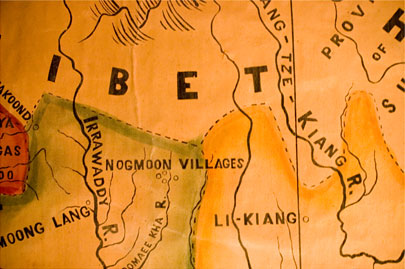
After so many years of tormenting me on the edges of my big map I will know you. My eye has found you on so many a night way up there perched above the French sounding Tati and the exotic Tali-Foo, on the edge of the edge of what was once known. Of course Nogmoon is not your real name, just the fantasy of some 19th century missionary, but a missionary with an ounce of humor. Humor enough to christen a dreary fly-blown city with an unpronounceable Mompa-language name Cuddleme, a name so appealing I spent 4 days and 4 nights trying to track it down only to arrive and be told the flies were "too heavy" and I must go to the next town to eat. Experiences in the equally prosaically named Busta and Jelii Jeli tells me you Nogmoon might be nothing, just another Chinese garrison on a dusty road to nowhere, but just maybe you are something amazing and so very soon, off I will go to uncover your secrets.
I'm almost out the door on my way to Litang and beyond, but I've been so swamped with work I haven't had a moment to think about it. Hard to believe in a few short days I will be here. Ok, enough of this, now back to work. Must finish project by tomorrow.

I am in Menlo Park, CA for the day on business. Tonight I am on the red eye back home.
If you are into street photography, you have probably already bookmarked, the always compelling quarlo.com. Slightly more obscure, but no less rss-worthy is Yamasaki's site. When they have new pictures on their sites, I always say to myself, "Ahh the Great Quarlo" and "Ahhh... Yamasaki the Great" and then they always deliver the goods.
I hate a great many things. I hate it when people say "have a good one". I hate cats. I hate renting and I hate humidity. I hate mosquitoes, people who call me chief, and the way cereal gets soggy so fast. I hate Mac Word 6.0, Karl Rove, and bad fonts. I hate Costco and PC Richards. I hate my forgetfulness. I hate rats (they scare me to death) and bureaucracy and that kid named Bill who spit on me in the 5th grade (I pegged him with a rock a few weeks later). I hate cleaning hair from drains, golf, Lance Armstrong bracelets, and the death of punk rock. I hate my clothes. I hate anything with coconut, the letter q, and the robber took my grandfather's chest full of photos. I especially hate losing friends over time, and the fact that Elsie's Oke Doke Pub on 84th between 1rst and 2nd is now closed. I hate not having sent all those wedding gifts and that I never write longhand letters anymore. I hate hate hate many of my friend's taste in music, a scar on my leg, and the inevitability of death (not my own so much, but of the people close to my heart). I hate not having a garden for Jenn to garden in; I hate no longer caring about baseball; I hate eggs. I hate the guy who went out of his way to blackball me from a club in college, direct overhead lighting (I prefer lamps), white walls, and the sound of my voice when recorded. So many things to hate in this imperfect world... People who know me will tell you I hate most movies these days. But I saw a movie I loved tonight. It's called, Me You and Everyone We Know by Miranda July and I think you should see it because when someone makes a great little film, or writes a book that moves you, or makes music that gets you dancing, there is, at least for a moment, a little less hate in the room and that can't be all bad.
In response to a couple of emails and a comment on the blog, here is my 2 cents on how to travel to Tibet cheaply:
1. Realize that Tibet is not just the Tibetan Autonomous Region, the Chinese designated Tibetan area on maps. Geographical, historical, cultural Tibet encompasses large swaths of what is now called Sichuan, Gansu, Yunnan, Qinhai, and Xinjiang. Travel in the Autonomous Region is heavily controlled by the Chinese government. Visas are expensive and there are lots of governmental hassles. Travel in the rest of Tibet does not require a visa and travel is unfettered by bureaucracy. As a side benefit, because of the way the lines are drawn on the map, as well as because of poor roads, high mountains, etc, tourists have largely ignored these areas.
2. Find a cheap round trip ticket to China. Generally the cheapest tickets are to Beijing/Shanghai/HongKong. This is your one big ticket item. But over the years I have always found cheap round trip tickets through diligence and planning ahead. Prices change daily sometimes hourly, so check often. Also try to travel in the off season. My current ticket was a little over $700 on China Air.
3. Get out of Beijing/Shanghai/HongKong ASAP. You can blow your whole budget in no time flat. If you must stay in one of these cities, stay with someone. There are thousands of Chinese bloggers to hook up with, travel exchange programs etc. There are cheapish hotels, but if you stay with someone most of your expenses will be taken care of.
Your destination from your point of entry will be Chengdu, Lanzhou, or Xining. These are the gateway cities.
Chinese trains are still ridiculously cheap. If you are buying train tickets and have trip of more than 9 hours go for the hard sleeper option, by far the best in the price to comfort ratio. Chinese Airfare is still super cheap. The nice thing about both planes and trains is that prices are fixed. Chinese airlines discount tickets as it gets closer to flight time if they have empty seats left. Chinese mass transit likes to be full. Don't bother getting tickets here. Get them there the day of or the day before departure.
When in one of these big cities check out the map room of the foreign language bookstores (usually hidden away upstairs). This is the best way to find maps with both Chinese characters and English translations. The bigger the map, the better. I usually buy one and cut it up. Most Western maps are terrible/inaccurate, but of all of them I've found Nelles Northern China/Southern China to be pretty good. The roads and cities are in the right place and the geographic info is useful. Still it is woefully incomplete. Chinese bus and train stations often have very good bus/train schedule booklets (with city maps). They are usually bound in blue or green and have pictures of buses and trains on the cover. Even though there is no English translation if you can match up characters they can be useful. In remote areas you won't have to worry about this. There is usually only one road, and schedules are clearly marked.
4. Once in Chengdu, Lanzhou, or Xining (these are also big cities with millions of people) head out by bus ASAP. Within one day of each of these cities, you will be in the mountains and immersed in Tibetan culture.
5. This is a map of some of my favorite bus routes. Note that each connection is generally 12-20 hours. Also most cities have 2 bus stations and many smaller independent private bus services. Even tiny cites often follow this rule.
By far the most popular route for backpackers is Chengdu-Songpan-Langmusi-Xiahe-Lanzhou and for good reason. Songpan is surrounded by National Parks and offers horse treks and camping. Langmusi is still a relatively unspoiled backpacker paradise and Xiahe is home to the Labrang monastery one of the biggest most active monasteries in all of Tibet. The popularity of this route is due to the Lonely Planet which many backpackers hold on to for dear life as they go through this area rarely venturing off the main road. But all the best places are off the main road. I recommend getting yourself a good map, ditching the LP, and just exploring. Feeling really adventurous. Just flag down a bus full of the most interesting looking Tibetans and go where they are going. This is easy if you follow my #1 travel rule which is to never take more than you can easily carry.
6. Once on the road your costs will be minimal. Even 20 hour bus trips are often only $5-20 and guest houses range from $2/night for a basic bed to $50/night in a place outfitted for Chinese tourists. I try to stick to the $2/night places. Food costs are negligible. In fact if you spend 2 months in Tibet traveling this way you'll generally spend much less than you would in say, New York City. Save money by traveling!
7. This is my plan for this trip (these plans always change on the road):
Chengdu
Chengdu-Kanding
Kanding-Lhagang-Manijiaguo
Manijiaguo-Litang
Litang-Nyarong-Kanze
Kanze-Pelyul
Pelyul-Katok-Dzongsar
Dzongsar-Pelpung-Derge
Derge-Manigango-Dzogchen
Dzogchen-Sershul
Sershul-Yushu
Yushu-Sershul-Zhechen
Zechen-Kanze
Kanze-Donggu-Serta
Serta-Serwa
Serwa-Baima
Baima-Jigzhi
Jigzhi (Drukcen Sumo)-Aba (Ngawa)
Aba-Longriba-Hongyuan
Hongyuan-Chengdu
If you are playing along on a map note that many of the cities have alternate spellings. Derge is Dege for example on many maps. Sershul is Serxu and so on. This is because there are Tibetan city names, Chinese city names and many alternate Romanizations.
People always ask about language issues, but these have never really been a problem. The further you get from "civilization" the more patient people will be with 'foreign devils'. That's about it, now you have no excuse not to hit the road. Many pictures from my previous trips can be found on my photoblog. I'll be posting images from my new trip there as well.
An account of one of my previous trips can be found here.
p.s. Many people don't feel like they've "done Tibet" (I hate the "doing" a country phrase by the way) unless they've visited Lhasa. I'm sad to inform you that Lhasa is Chinese Disneyland. The Potala Palace is a museum and this city is now majority Chinese. If you must go, the cheapest ways to get there are by bus from Golmud in Qinhai or via Zhongdian in Yunnan. Rules and regulation seem to change daily but both cities have backpacker friendly travel places that will arrange the permits.
Then newseum will be pure honey. A map view is also available. (via Design Observer)
A few weeks ago on the subway I overheard a lady say there are no fireflies in Brooklyn. The comment bounced around my head. It's the type of thing I remember. Sad. Then a few nights ago when lying next to my son, I noticed his eyes wander beyond me followed by utter rapture. A light on our phone was blinking. Voicemail. Each blink threw orange light onto the walls and to his unpolluted brain it was a vision somewhere between beauty and magic. This got me to thinking about fireflies again. When I was a kid we lived on the edge of the forest. At twilight on hot summer nights the fireflies would come. First one, then another, and then suddenly hundreds even thousands. Sometimes they would cluster in balls moving together through the trees in a strange and beautiful orgy of activity throwing dim shadows in all directions. The light was like a siren song, but we knew better than to cross the barbed wire into the the forest. We had heard too many stories. With fog the shadows were spooky and would send us running home, but fog was rare. Most nights we would draw them out with penlights following the pattern of their blinks. Strays would wander toward us over the grass flying low and slow only to be caught and smeared like warpaint on our faces and chests. Others would go into bottles that would sit by our beds lighting the ceiling late into the night to be released first thing in the morning. How could we have known then that time would be so short because in that moment time seemed endless. And these thoughts made me sad for my son who I realized had not yet seen fireflies and as a city kid might know these pleasures only as exotic rarities when visiting the countryside.
Tonight Jenn was at her writing workshop and I was in charge of putting the boy to sleep. He was fidgety so I decided to sit out on the stoop for a while with him in my arms. I was watching the empty taxis returning to Manhattan, but his focus was in the tree above. And then that look. Before I turned my head somehow I knew what I would see. Fireflies--a couple of them, blinking around, oblivious to the streets below. I watched them for a very long time and perhaps if you had passed by my face would have that look as well, for it wasn't just our tree, it was all the trees on the block. The night grew darker, the fireflies glowed brighter. And then one came towards me. Without a moments hesitation I reached up and caught it, my hand in a hollow fist. I could see the light coming between my fingers as it crawled around looking for escape. I brought my hand down to open it in front of my son's face and watch his reaction, but he had already absorbed the moment. His eyes were closed. I thought of waking him, but no. He had crossed into the river of sleep and that was that. I opened my hand.
I wanted it to be known for the record: Brooklyn has plenty of fireflies. Lady, you were wrong.
Sometimes people ask about my mother-in-law. Becky's blog post titled "Momisms" (Becky is my wife's sister) is a good place to start your study of her.
. . .
Becky's post about Margie the tollbooth operator is also worth checking out.
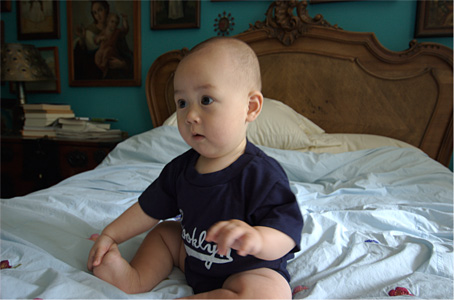
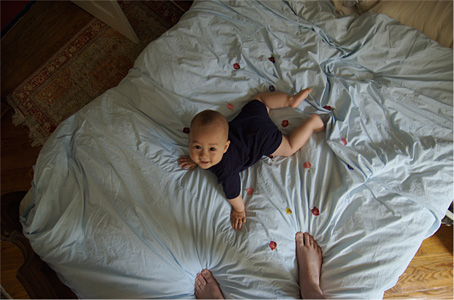
2 Weeks. I'm counting off the days before I depart for Kham, the Litang Horse Festival. and beyond. I have a few private rules about "out there" travel, the first being that one should not take more than they can easily carry. This is a little list I wrote for myself long ago:
How to Prepare
1. One bag.
2. Bring a small book with photos from your life.
3. 2 places to hide money (I use a moneybelt and a pouch).
4. Cash converted to local currency.
5. Xerox all documents, credit cards ect.
6. Study the Lonely Planet (and other guide books), but leave them at home.
7. Bring a notebook, and use it.
8. Find the best map.
9. Take the smallest road.
10. Get lost (because this is where the journey begins)
What to do once you are there
1. Don't randomly stick a camera in people's faces. Slow down. Hang out. Take out your camera only when you are leaving.
2. Eat what local people eat, as long as it's hot.
3. Drink more water than you think you need, but make sure it is well purified (I use idodine).
4. Travel using local trains and buses.
5. Avoid places with English menus unless you are in England.
6. Wander around at night (only then can you guarantee anonymity).
7. Even if you can't speak the language you can always talk to people via sign language and patience. If you can't communicate at the very least smile.
8. Ask questions.
9. Don't complain about: bathrooms, hotels, food, buses, etc
10. Go someplace that scares you a little.
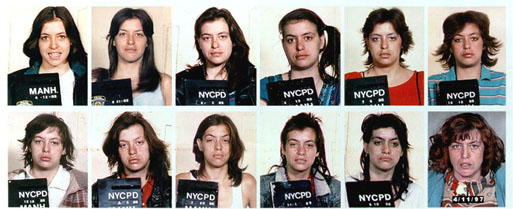
Knowing my fascination with time and aging photography projects, Noah of Noah K Everyday (and it's parent site NoahKalina.com) has pointed me to the excellent Olivia Project. Sadly the project seems to have ended in 2004.
A full page of excellent time and "obsessive" art projects can be found at c71123.com. Lots of good stuff like "One Year Performance" by Tehching Hsieh. Beware, this list of links could eat your afternoon.
I used to maintain a sequential series, but I let it fall out of date but somewhere in storage there is a box with 5 years of polaroids of my head. I have a few other time related juxtapositions here, here, here, and here. Luckily now I have a kid to experiment on.
The short version is:
We went to the Catskills for a wedding.
The wedding was lovely although we were super late to the ceremony (much to our horror), but otherwise everything ran smoothly and the bride and groom radiated a happy calm throughout. We had a great table or fellow Brooklynites, and we danced. The weather cooperated. The evenings ended with bonfires, sparklers, and fireflies. An unbeatable combination just about anywhere.
Raul Andres had many firsts: first time on grass (an upsetting experience), first time seeing a stream (he enjoyed it), first time in the pool (he's getting the hang of it), first time at a carnival (seemed to love it), first time for fireworks (they rattled him) etc. We're realizing to our horror that he is something of a city kid and needs to get out in nature more.
As a bonus Jenn's sister Becky tagged along for the weekend to help us with the baby. We had promised her a nice weekend away, but our hotel was more motel. Damn internet advertising. Sorry about the place Becks. Next time we'll do better. Still even with the sad Cobblestone Motel, we had lots of laughs.
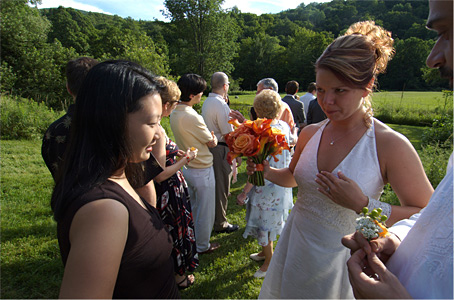
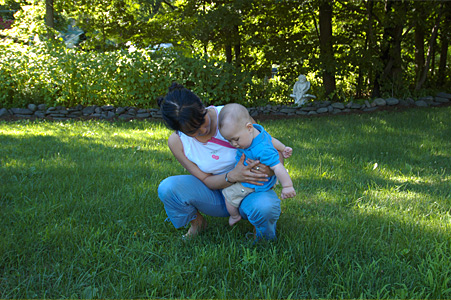
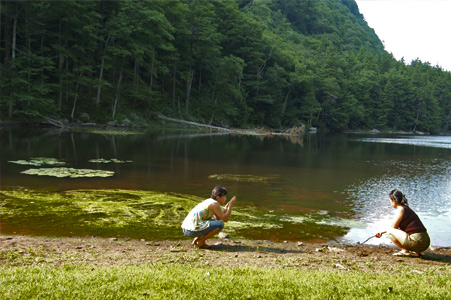
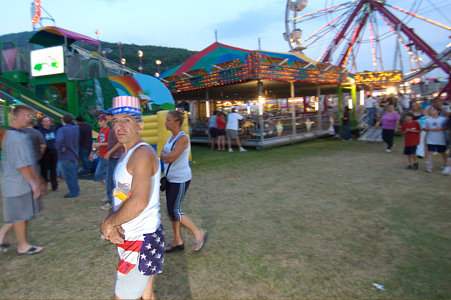
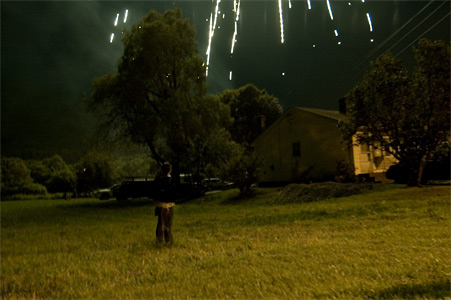
. . . . .
I don't know why but I remember my July 4th's even better than Christmases, Thanksgivings, or New Years. Christmases all run together. Thanksgiving is a blur of food and New Years is too mixed up with the deaths in my family for me to sort them out. But July 4ths are crystal clear. If you were to sit me down, I could tell you where I was and what I was doing on every July 4th back to junior high school.
Last July 4th Jenn and I were just starting to pack up the house in LA for our move here. She was four months pregnant and we were just starting feel we were no longer two but three. The feeling was unformed though, full of unknowns. For Jenn the reality was facing her in the mirror each day as her body changed, and she was beginning to experience those small internal kicks that make the abstract real, but for me it was all still theoretical. For hours we would discuss the possibilities "what if he" or "what if she"...
We drove up to Santa Barbara on a whim. It was one of those perfect California days and we drove with the windows down listening to music not talking much. On long trips my wife always puts her feet up on the dashboard despite my protestations and one was no exception. Santa Barbara was crowded but by luck we found an empty room at a good hotel by the beach. The fireworks were perfect as was the nighttime swim in the heated pool later on. Afterwards wrapped ourselves in towels, left the window ajar for the breeze, and plotted and planned late into the night.
A year is only 365 days, but that was another life.
I was talking to someone at the wedding this weekend about parerenthoodhood this is the best I could come up with: When we look back at our life before, as happy and as in love as we were, when we remember that time now we feel as if we were missing this person who had not yet been born. We didn't know it yet, but our lives while so very full, were still empty.
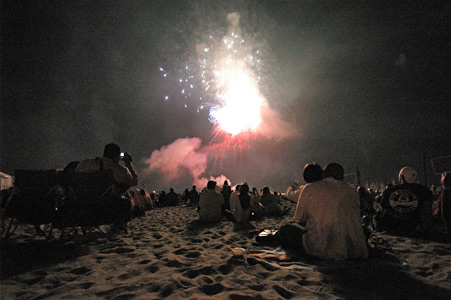
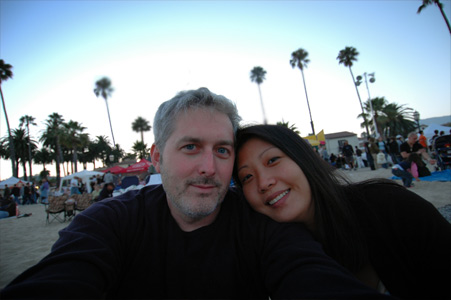
« Previous 15 Posts
« Previous Post (My 4 Year Old On What Makes a Good Shoe)
2019
:
Jan
.
2016
:
Mar
.
2015
:
Dec
.
2014
:
Oct
.
2013
:
May
.
Apr
.
Mar
.
2012
:
Oct
.
Sep
.
Aug
.
Jul
.
Jun
.
May
.
Mar
.
Feb
.
Jan
.
2011
:
Dec
.
Nov
.
Oct
.
Sep
.
Aug
.
Jul
.
Jun
.
May
.
Apr
.
Mar
.
Feb
.
Jan
.
2010
:
Dec
.
Nov
.
Oct
.
Sep
.
Aug
.
Jul
.
Jun
.
May
.
Apr
.
Mar
.
Feb
.
Jan
.
2009
:
Dec
.
Nov
.
Oct
.
Sep
.
Aug
.
Jul
.
Jun
.
May
.
Apr
.
Mar
.
Feb
.
Jan
.
2008
:
Dec
.
Nov
.
Oct
.
Sep
.
Aug
.
Jul
.
Jun
.
May
.
Apr
.
Mar
.
Feb
.
Jan
.
2007
:
Dec
.
Nov
.
Oct
.
Sep
.
Aug
.
Jul
.
Jun
.
May
.
Apr
.
Mar
.
Feb
.
Jan
.
2006
:
Dec
.
Nov
.
Oct
.
Sep
.
Aug
.
Jul
.
Jun
.
May
.
Apr
.
Mar
.
Feb
.
Jan
.
2005
:
Dec
.
Nov
.
Oct
.
Sep
.
Aug
.
Jul
.
Jun
.
May
.
Apr
.
Mar
.
Feb
.
Jan
.
2004
:
Dec
.
Nov
.
Oct
.
Sep
.
Aug
.
Jul
.
Mar
.
2003
:
Apr
.
1999
:
May
.












